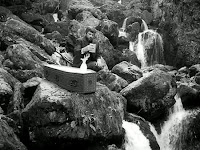Art: the Pre-Raphaelites (1)
Well, we left you at the doors of Tate Britain, as it were, about to enter this exhibition. The Guardian gave it quite a lengthy review. Alice has been in a fever of image hunting, editing and Googling-up references for our account. I'm sure most of you would be quite happy with a selection of nice pictures and just a few words - but there's no stopping her once she gets going... So, forgive the delay.
 Alice's earliest memory of learning more about the Pre-Raphaelites, was seeing
a very sexy, gory, and compelling 1967 BBC film directed by the infamous Ken Russell and starring Oliver Reed, called Dante's Inferno. The eponymous [I do like these erudite words!] Dante being not the ancient Italian poet, who wrote about true love and the Circles of Hell, but Dante Gabrielle Rossetti, the poet, painter and one of the founders of the Pre-Raphaelite Brotherhood, with Holman Hunt and Millais.
Alice's earliest memory of learning more about the Pre-Raphaelites, was seeing
a very sexy, gory, and compelling 1967 BBC film directed by the infamous Ken Russell and starring Oliver Reed, called Dante's Inferno. The eponymous [I do like these erudite words!] Dante being not the ancient Italian poet, who wrote about true love and the Circles of Hell, but Dante Gabrielle Rossetti, the poet, painter and one of the founders of the Pre-Raphaelite Brotherhood, with Holman Hunt and Millais.Whew! What a lot of links... But they're not obligatory. Alice just likes finding them.
 I expect most of you will be familiar with Millais' famous painting of Ophelia. [Click on any image to see it larger, or better still, open in a new tab.] Shakespeare's Ophelia is a really tragic case, isn't she?
I expect most of you will be familiar with Millais' famous painting of Ophelia. [Click on any image to see it larger, or better still, open in a new tab.] Shakespeare's Ophelia is a really tragic case, isn't she?Did you know, though, that the details of the scene were copied from nature, but Ophelia herself was modelled on poor Elizabeth Siddal, who lay in a bath for four months? That didn't help her health at all. She miscarried Rossetti's baby, and died of a laudanum overdose, most probably suicide. It was a drug so easy to get hold of then, that a lot of Victorians became addicts.
We couldn't find out who took this photo of Lizzie. Alice likes to imagine it was Julia Margaret Cameron, because she was a woman who took lots of photographs, including some of Alice Liddell. Wish on, dear...
The Pre-Raphaelites seemed to have had a penchant for luscious ladies with red, pouty lips, and there were indeed a great many of those in the exhibition.
 There was a perfectly stunning young man, however.
There was a perfectly stunning young man, however.This Bacchus, the god of drunkenness and general dissipation, by Simeon Solomon was beautiful.
I especially liked all the little cracks in the paint, even if Alice did say that was silly, as the original wouldn't have had any. But it reminded me how old the artefact actually was: 1867 - awesome.
There were lots of paintings with religious themes, including this famous (but rather ghastly) Scapegoat by Hunt. Apparently he went all the way to the Holy Land - no mean feat in those days - to get the authentic background. And he seemed to have found a goat that was dying. You wouldn't be allowed to do that in a film today. [You simply must follow that last link. It's priceless! Then click the headings and watch carefully, too.]
Alice explained that a "scapegoat" is supposed to take on the sins of the community, and be punished for them. Needn't be a goat, could be a "cutty wren", even. Sounds nutty to me, but religious people believe that Christ did that for everyone. It's called vicarious atonement. Rather a nasty sort of god who's that vindictive, I reckon. Alice is nodding.
 Rossetti's Annunciation was more to my taste. Mary looks kind of scared, but she would be, wouldn't she? It's not that often a real androgynous angel appears in your bedroom. I like the way its flaming feet are floating just above the floor, with what looks like flaming shadows. [Click to enlarge]
Rossetti's Annunciation was more to my taste. Mary looks kind of scared, but she would be, wouldn't she? It's not that often a real androgynous angel appears in your bedroom. I like the way its flaming feet are floating just above the floor, with what looks like flaming shadows. [Click to enlarge]Alice's favourite angel story is the one in Wim Wender's marvellous Wings of Desire. It makes superb use of changes between black-and-white while the angel is in heaven, and colour when he "falls" to earth to experience the joy of human senses. They remade it as City of Angels with Nicolas Cage and his terribly mournful eyes, but it just didn't have the same subtlety.
We're going to pause here, and finish our musings on the Pre-Raphaelites another time. So do come back.

.jpg)

